Energy Action Mechanism of Reinforced Sandstone under Triaxial Cyclic Loading and Unloading
Abstract
:1. Introduction
2. Test Part
2.1. Experiment Material and Test Equipment
2.2. Specimen Preparation
2.3. Test Scheme
3. Analysis of Stress–Strain Curves
4. Analysis of Energy Evolution Characteristics
4.1. Method of Energy Calculation
4.2. Analysis of Energy Evolution
4.3. Analysis of Energy Evolution of Various Reinforcement Schemes
4.4. Analysis of Energy Evolution under Various Confining Pressures
4.5. Analysis of Energy Distribution
4.6. Analysis of Energy Damage Characteristics
5. Conclusions
- In the triaxial cyclic loading and unloading test, the reinforcement effect of the CFRP material was relatively ideal, and the initial damage caused by bolt drilling was effectively avoided, which provides a new direction for the research on underground engineering support materials.
- CFRP improved the strength deformation parameters and shear strength parameters of sandstone effectively, and the reinforcement effect increased with the increase in the reinforced area.
- CFRP restricted the axial strain expansion by limiting the radial strain and inhibited the occurrence and expansion of internal microcracks so that more elastic energy can be accumulated during loading. This was the intrinsic reason for improving the strength of the specimen.
- CFRP began to play a role in the early stage of loading, and the reinforcement effect became increasingly obvious as the loading entered the plastic deformation stage. In the residual strength stage, the CFRP effectively limited the energy release or dissipation during rock failure.
- As the reinforcement area increased, the energy characteristic density and peak strain increased. However, the proportion of elastic energy increased, and the proportion of dissipated energy decreased, indicating that the CFRP improved the energy absorption efficiency, enhanced the energy storage limit, slowed down the dissipation efficiency, and increased the peak strain of dissipated energy.
- Under the same confining pressure, the damage variable decreased with the increase in the reinforcement area when the same coaxial strain occurred. Therefore, CFRP annular reinforcement reduced intergranular dislocation and inhibited the development of cracks and damage in the rock mass, which is the essence of constraint reinforcement.
Author Contributions
Funding
Institutional Review Board Statement
Informed Consent Statement
Data Availability Statement
Conflicts of Interest
References
- Xie, H.P.; Li, L.Y.; Peng, R.D.; Ju, Y. Energy analysis and criteria for structural failure of rocks. J. Rock Mech. Geotech. 2009, 1, 11–20. [Google Scholar] [CrossRef] [Green Version]
- Xie, H.P.; Li, L.Y.; Ju, Y.; Peng, R.D.; Yang, Y.M. Energy analysis for damage and catastrophic failure of rocks. Sci. China Technol. Sc. 2011, 54, 199–209. [Google Scholar] [CrossRef]
- Wu, X.; Jiang, Y.; Li, B. Influence of joint roughness on the shear behaviour of fully encapsulated rock bolt. Rock Mech. Rock Eng. 2017, 51, 953–959. [Google Scholar] [CrossRef]
- Wu, X.; Jiang, Y.; Gong, B.; Guan, Z.; Deng, T. Shear performance of rock joint reinforced by fully encapsulated rock bolt under cyclic loading condition. Rock Mech. Rock Eng. 2019, 52, 2681–2690. [Google Scholar] [CrossRef]
- Cao, Q.; Li, X.J.; Zhou, J.P.; John, M. Expansive concrete confined by CFRP under eccentric compression. Constr. Build Mater. 2019, 208, 113–124. [Google Scholar] [CrossRef]
- Zaki, M.A.; Rasheed, H.A.; Alkhrdaji, T. Performance of CFRP-strengthened concrete beams fastened with distributed CFRP dowel and fiber anchors. Compos. Part B-Eng. 2019, 176, 107117. [Google Scholar] [CrossRef]
- Ghoroubı, R.; Mercimek, Ö.; Sakın, S.; Anıl, Ö. Novel bond-slip model between concrete and angular CFRP fan type anchoraged CFRP strip. Eur. J. Environ. Civ. Eng. 2022, 26, 5404–5427. [Google Scholar] [CrossRef]
- Haddad, R.H.; Harb, A.N. Varying profiles of CFRP ropes for strengthening concrete beams. Int. J. Civ. Eng. 2022, 20, 405–419. [Google Scholar] [CrossRef]
- Peng, K.; Wang, Q.; Shao, Y. Study on compressive-torsional behaviour of square concrete filled CFRP-steel tube (S-CF-CFRP-ST). Ocean Eng. 2022, 262, 112217. [Google Scholar] [CrossRef]
- Tang, H.; Wang, H.; Liu, R.Z.; Zou, X.; Jia, Y.G. Axial compression behavior of CFRP-confined square concrete-filled double skin tube stub columns with stainless steel outer tube. Ocean Eng. 2022, 266, 112871. [Google Scholar] [CrossRef]
- Li, B.; Hu, R.; Bai, S.; Dong, W.G.; Zhao, Z.L.; Song, L.J. Mechanical performance of concrete strengthened by modified epoxy resin bonded CFRR. J. Adhes. Sci. Technol. 2022, 36, 1764–1780. [Google Scholar] [CrossRef]
- Ding, F.X.; Lu, D.R.; Bai, Y.; Gong, Y.Z.; Yu, Z.W.; Ni, M.; Li, W. Behaviour of CFRP-confined concrete-filled circular steel tube stub columns under axial loading. Thin. Wall Struct. 2018, 125, 107–118. [Google Scholar] [CrossRef]
- Carrillo, J.; Rodríguez, D.; Villar-Salinas, S. Contribution of CFRP to the shear strength of retrofitted lightly-reinforced concrete panels. J. Build Eng. 2021, 44, 102722. [Google Scholar] [CrossRef]
- Huang, Z.; Zhao, Y.k.; Zhang, J.W.; Wu, Y. Punching shear behaviour of concrete slabs reinforced with CFRP grids. Structures 2020, 26, 617–625. [Google Scholar] [CrossRef]
- Wang, L.; Zhang, J.; Chen, W.; Fu, F.; Qian, K. Short term crack width prediction of CFRP bars reinforced coral concrete. Eng. Struct. 2020, 218, 110829. [Google Scholar] [CrossRef]
- Dong, H.; Zhou, Y.; Zhuang, N. Study on Corrosion Characteristics of Concrete-Filled CFRP-Steel Tube Piles under Hygrothermal Environment. Adv. Mater. Sci. Eng. 2020, 2020, 4849038. [Google Scholar] [CrossRef] [Green Version]
- Chen, L.; Lu, P.P.; Zhang, S.G. Failure mechanism and energy damage evolution of deep sandstone anchored by carbon fiber. KSCE J. Civ. Eng. 2022, 26, 1929–1949. [Google Scholar] [CrossRef]
- Li, Z.Y.; Xie, S.; Song, Q.H.; Wang, P.Y.; Liu, D.Y.; Zhao, B.Y.; Huang, W. Rock unloading failure characteristics and acoustic emission precursors. Adv. Mater. Sci. Eng. 2022, 2022, 1212584. [Google Scholar] [CrossRef]
- Meng, Q.B.; Liu, J.F.; Ren, L.; Pu, H.; Chen, Y.L. Experimental study on rock strength and deformation characteristics under triaxial cyclic loading and unloading conditions. Rock Mech. Rock Eng. 2021, 54, 777–797. [Google Scholar] [CrossRef]
- Meng, Q.B.; Zhang, M.W.; Zhang, Z.Z.; Han, L.J.; Pu, H. Research on non-linear characteristics of rock energy evolution under uniaxial cyclic loading and unloading conditions. Environ. Earth Sci. 2019, 78, 1–20. [Google Scholar] [CrossRef]
- Miao, S.J.; Xia, D.H.; Yang, P.J.; Liang, M.C. Acoustic emission and damage characteristics of granite under graded cyclic loading. Arab. J. Geosci. 2022, 15, 977. [Google Scholar] [CrossRef]
- Xie, H.P.; Jiu, Y.; Li, L. Criteria for strength and structural failure of rocks based on energy dissipation and energy release principles. Chin. J. Rock Mech. Eng. 2005, 24, 3003–3010. (In Chinese) [Google Scholar] [CrossRef]
- Gautam, P.K.; Dwivedi, R.; Kumar, A.; Kumar, A.; Verma, A.K.; Singh, K.H.; Singh, T.N. Damage characteristics of jalore granitic rocks after thermal cycling effect for nuclear waste repository. Rock Mech Rock Eng. 2021, 54, 235–254. [Google Scholar] [CrossRef]

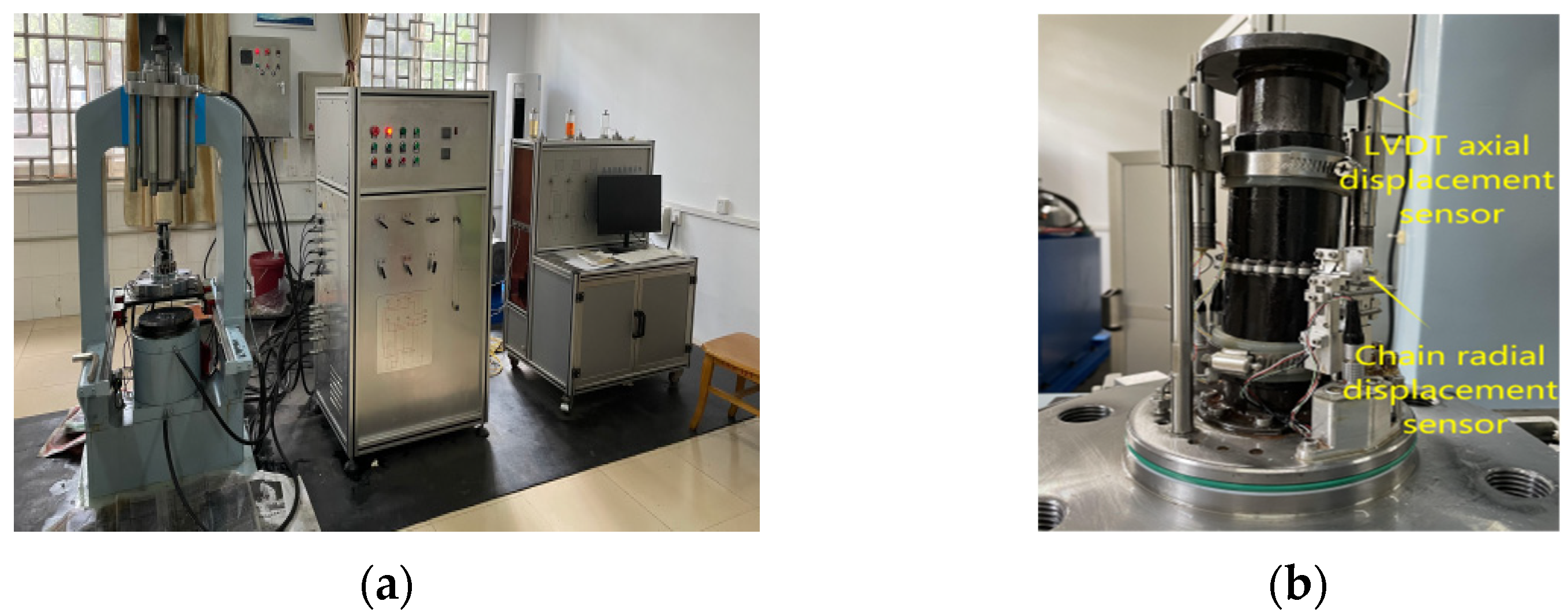
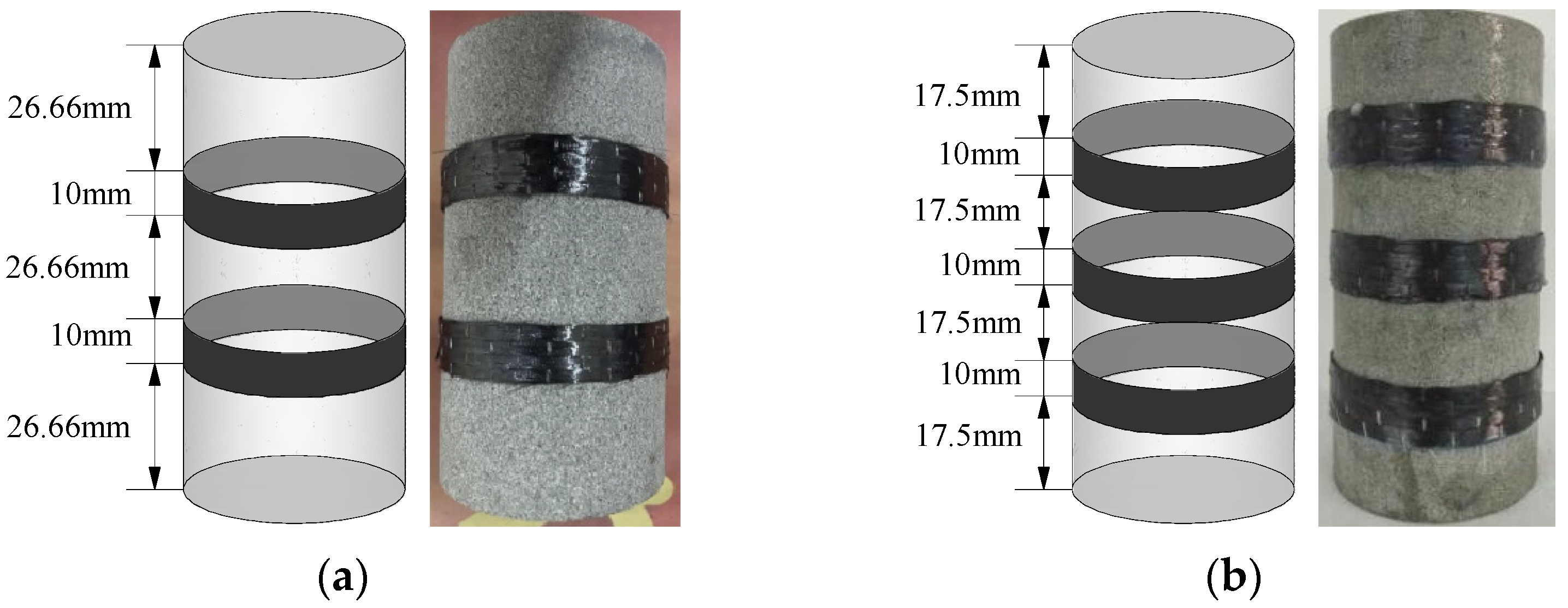



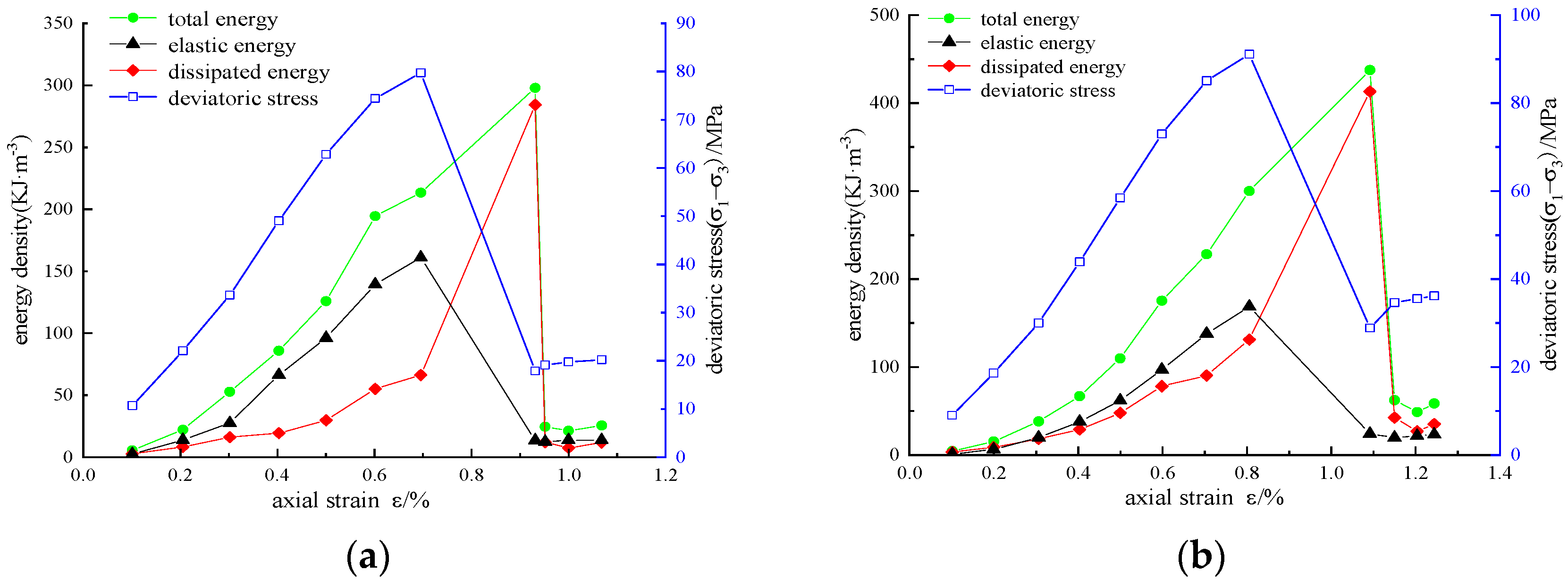
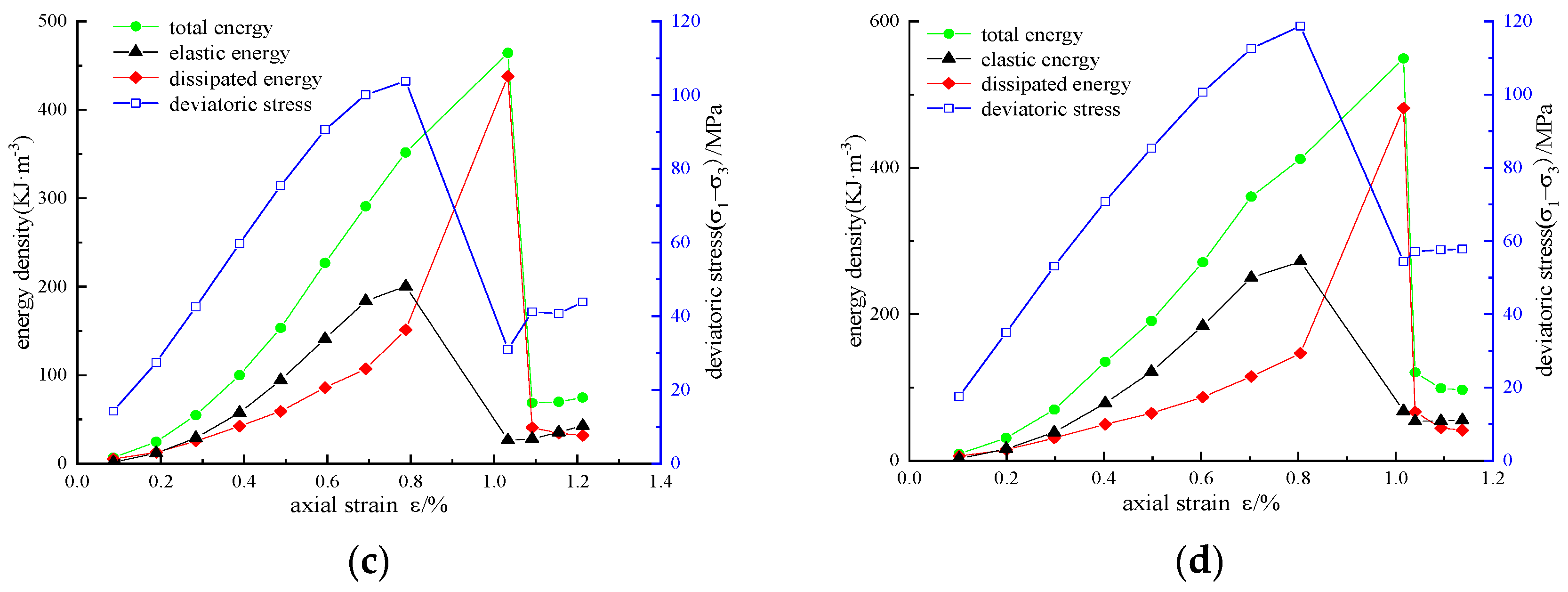

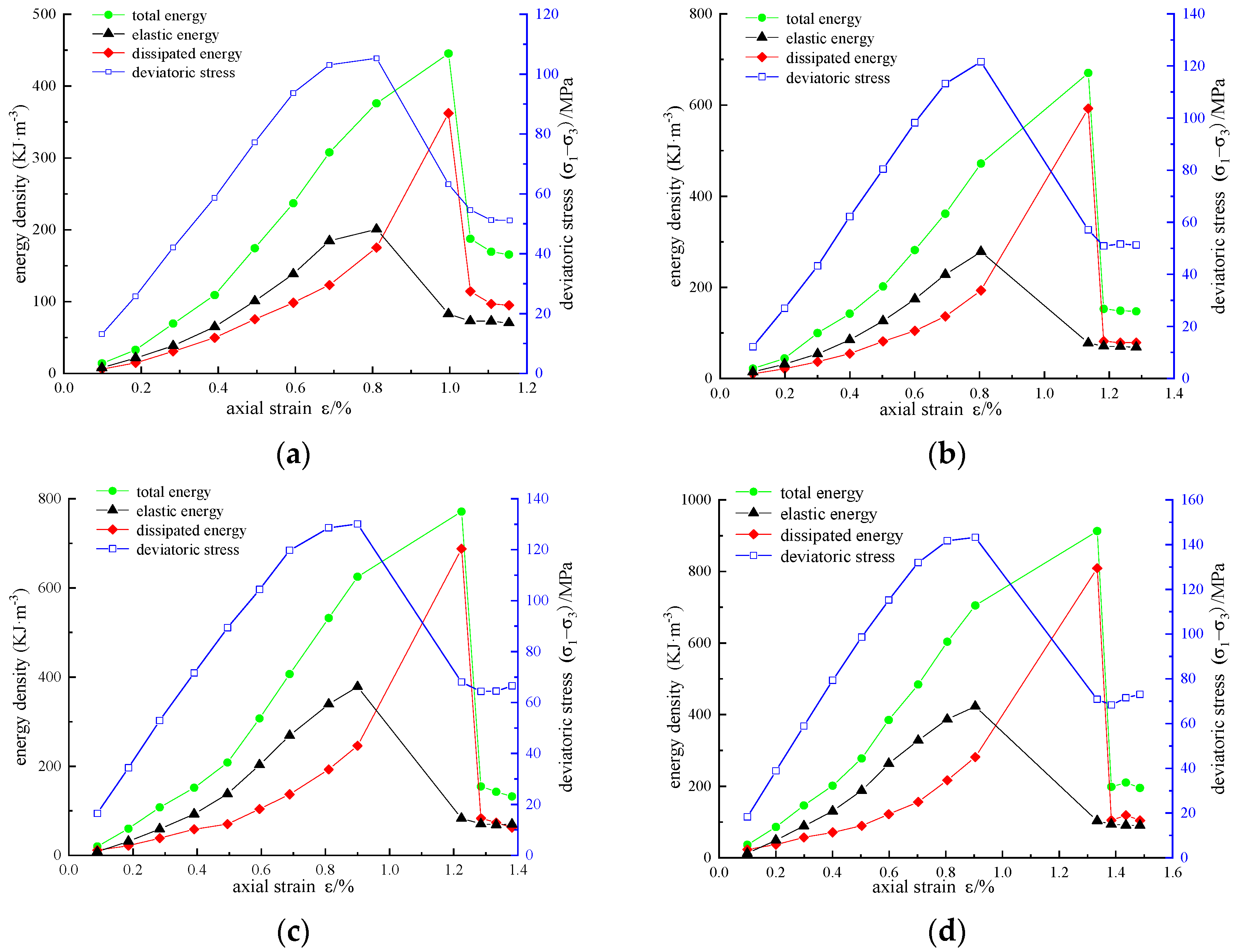




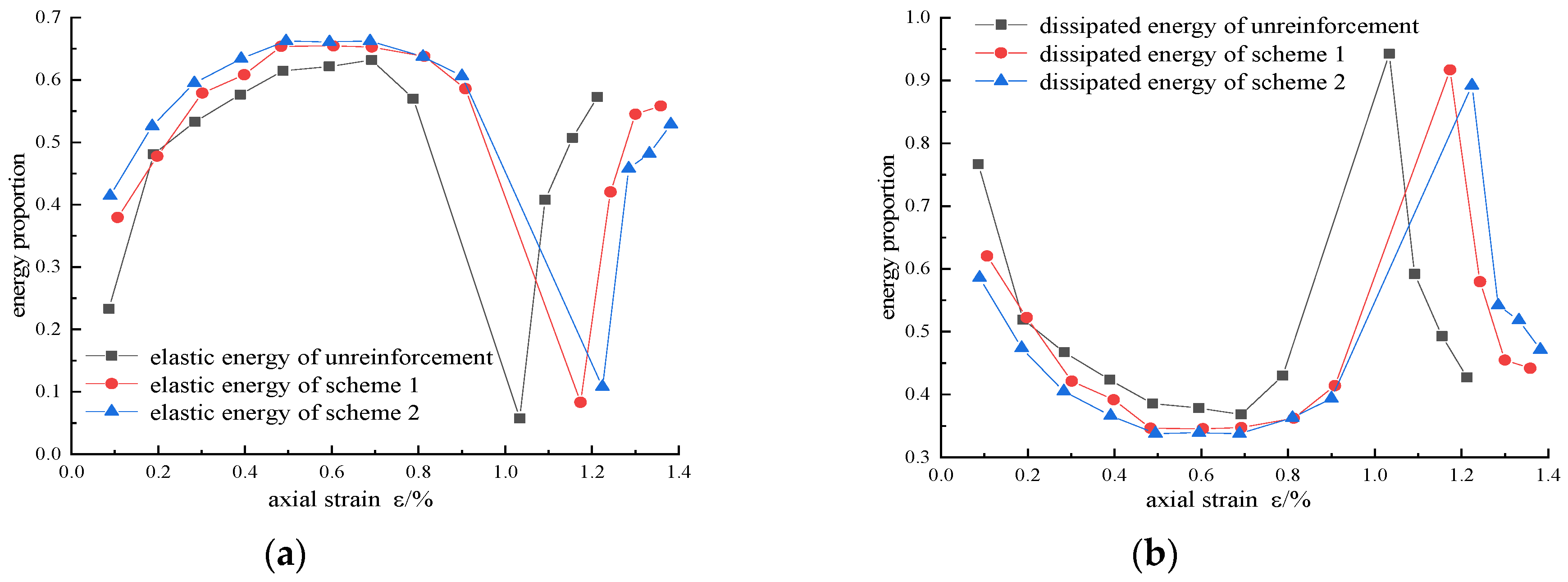


| Parameters | Tensile Strength (MPa) | Elasticity Modulus (Gpa) | Elongation (%) | Bending Strength (MPa) |
|---|---|---|---|---|
| CFRP | ≥3000 | ≥200 | ≥1.5 | ≥600 |
| Impregnated glue | ≥35 | ≥2200 | ≥1.3 | ≥40 |
| Reinforcement Schemes | Peak Strength (MPa) | Axial Peak Strain (%) | Radial Peak Strain (%) | Residual Strength (MPa) | Cohesion (MPa) | Friction Angle (°) |
|---|---|---|---|---|---|---|
| Unreinforced | 104.61 | 0.7875 | −0.1589 | 42.05 | 20.57 | 26.25 |
| Scheme 1 | 119.94 | 0.9097 | −0.2071 | 52.29 | 26 | 26.27 |
| Scheme 2 | 130.19 | 0.9248 | −0.2747 | 64.41 | 28.05 | 27.41 |
Disclaimer/Publisher’s Note: The statements, opinions and data contained in all publications are solely those of the individual author(s) and contributor(s) and not of MDPI and/or the editor(s). MDPI and/or the editor(s) disclaim responsibility for any injury to people or property resulting from any ideas, methods, instructions or products referred to in the content. |
© 2022 by the authors. Licensee MDPI, Basel, Switzerland. This article is an open access article distributed under the terms and conditions of the Creative Commons Attribution (CC BY) license (https://creativecommons.org/licenses/by/4.0/).
Share and Cite
Zhang, S.; Li, Y.; Yang, J.; Song, Y.; Yang, L.; Guo, J. Energy Action Mechanism of Reinforced Sandstone under Triaxial Cyclic Loading and Unloading. Materials 2023, 16, 211. https://doi.org/10.3390/ma16010211
Zhang S, Li Y, Yang J, Song Y, Yang L, Guo J. Energy Action Mechanism of Reinforced Sandstone under Triaxial Cyclic Loading and Unloading. Materials. 2023; 16(1):211. https://doi.org/10.3390/ma16010211
Chicago/Turabian StyleZhang, Shuguang, Yanmo Li, Juefeng Yang, Yu Song, Li Yang, and Jiahao Guo. 2023. "Energy Action Mechanism of Reinforced Sandstone under Triaxial Cyclic Loading and Unloading" Materials 16, no. 1: 211. https://doi.org/10.3390/ma16010211






